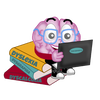Recognizing the Signs of Dyscalculia: Understanding the Learning Difference that Affects Mathematical AbilitiesWhat is Dyscalculia? Dyscalculia is not as widely researched as it's cousins Dyslexia and Dysgraphia. Dyscalculia is the result of a neurological difference that results in difficulty in understanding sequencing, mathematical concepts and memorization of multiplication facts. Dyscalculia was originally defined by the Czechoslovakia researcher Kosc, as a difficulty in mathematics as a result of impairment to particular parts of the brain involved in mathematical cognition, but without a general difficulty in cognitive function. Dyscalculia includes difficulty in learning or comprehending arithmetic, such as difficulty in understanding numbers, learning how to manipulate numbers, and learning facts in mathematics, involving difficulties with time, measurement, and spatial reasoning. People with dyscalculia have difficulty working with numbers in a variety of ways.
There is another type of dyscalculia called "acquired dyscalculia" which is acquired (usually in adults) as a result of brain injury or stroke. We will not be addressing this type of Dyscalculia. Below you will find a list of signs that are likely indicators that you or your child has Dyscalculia. We provide tutoring services for students who struggle learning math traditionally. Common Signs of Dyscalculia
0 Comments
Your comment will be posted after it is approved.
Leave a Reply. |
LEXIA LEARNERS LOUNGE
AuthorJess Arce is a homeschool mom of four, a tutor for children & adults who struggle with Dyslexia & Dysgraphia and an all around entrepreneur. She is passionate about helping others understand dyslexia. |
